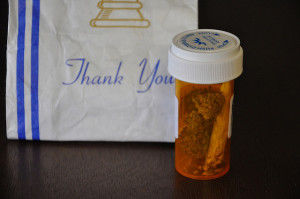Growing up in a conservative household, it wasn’t hard to imagine that I would oppose the use of marijuana. That my bias would be to cherry-pick those studies that showed no efficacy in medical marijuana, and to see the pot-heads as being self-interested in legalizing marijuana. But my mind was changed not just by anecdotes of friends who had found usefulness in marijuana when other drugs did not use, but by the hard facts of science.
Opioid Epidemic
I have written about the opioid epidemic previously. But a study came out showing that in those states where medical marijuana is allowed (17 states by 2013) there were over 1800 fewer doses of pain medicine prescribed by physicians. The use of medical marijuana for chronic pain is a field that worthy of research. There are enough anecdotes, as well as clinical studies, showing the effectiveness of some compounds of marijuana that reduce chronic pain.
Still the DEA has marijuana listed as a schedule 1 drug – meaning that the DEA says marijuana should not even be researched. The FDA has relaxed this, and there are a number of places that are doing research on marijuana – but under strict guidelines.
Other Prescription Drug Decreases Noted:

Pain: 1826 fewer doses
Anxiety: 562 fewer doses
Nausea: 541 fewer doses
Psychosis: 519 fewer doses
Seizures: 486 fewer doses
Sleep disorders: 362 fewer doses
Depression: 265 fewer doses
This shows that medical marijuana is used for medicine – not just recreation.
But some pharmaceutical companies oppose marijuana reform. Not surprising – see the above chart.
There is plenty of evidence to the contrary – but because of restrictions placed upon research with medical marijuana those studies are tainted by the inability to obtain good data.
We need to define the range of drug for efficacy and toxicity. We need to get marijuana out of woo and into science. Find the active compounds, purify them, quantitate them. For every medically active compound there is a range where it is ineffective, effective, and toxic. We need to define those. It should not be just left to the “cowboy” growers to define that for us. It must be done with science and under FDA scrutiny.
For those who thinks marijuana will cure cancer – well, there may be some active metabolites, but it won’t cure cancer. We have to define that. Too many people with cancer fall victim to peddlers of junk science.
What this means:
Here is the DEA schedules for drugs. I advocate moving marijuana from schedule I to schedule III or IV.
Schedule I
Schedule I drugs, substances, or chemicals are defined as drugs with no currently accepted medical use and a high potential for abuse. Schedule I drugs are the most dangerous drugs of all the drug schedules with potentially severe psychological or physical dependence. Some examples of Schedule I drugs are:
heroin, lysergic acid diethylamide (LSD), marijuana (cannabis), 3,4-methylenedioxymethamphetamine (ecstasy), methaqualone, and peyote
Schedule II
Schedule II drugs, substances, or chemicals are defined as drugs with a high potential for abuse, with use potentially leading to severe psychological or physical dependence. These drugs are also considered dangerous. Some examples of Schedule II drugs are:
Combination products with less than 15 milligrams of hydrocodone per dosage unit (Vicodin), cocaine, methamphetamine, methadone, hydromorphone (Dilaudid), meperidine (Demerol), oxycodone (OxyContin), fentanyl, Dexedrine, Adderall, and Ritalin
Schedule III
Schedule III drugs, substances, or chemicals are defined as drugs with a moderate to low potential for physical and psychological dependence. Schedule III drugs abuse potential is less than Schedule I and Schedule II drugs but more than Schedule IV. Some examples of Schedule III drugs are:
Products containing less than 90 milligrams of codeine per dosage unit (Tylenol with codeine), ketamine, anabolic steroids, testosterone
REFERENCES:
Health Aff (Millwood). 2016 Jul 1;35(7):1230-6. doi: 10.1377/hlthaff.2015.1661. Medical Marijuana Laws Reduce Prescription Medication Use In Medicare Part D.Bradford AC, Bradford WD. PMID: 27385238
Ann Med. 2016 May;48(3):128-41. doi: 10.3109/07853890.2016.1145794. Epub 2016 Feb 25.Cannabinoids: Medical implications.Schrot RJ, Hubbard JR PMID: 26912385
Can Fam Physician. 2015 Aug;61(8):e372-81.Efficacy and adverse effects of medical marijuana for chronic noncancer pain: Systematic review of randomized controlled trials. Deshpande A, Mailis-Gagnon A, Zoheiry N, Lakha SF. PMID:26505059
